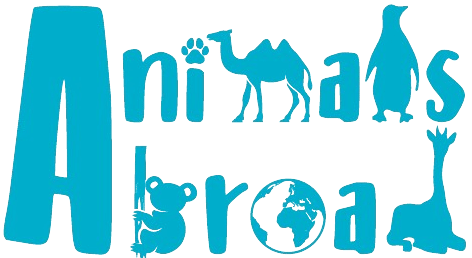Crossing borders in Southern Africa can be an adventure of its own—sometimes smooth, often confusing, occasionally funny, but always memorable. Over our 51-day overland safari through South Africa, Namibia, Zambia, and Botswana, we crossed several borders with our rental truck, two kids, and loads of gear. We never quite knew what to expect, and border days were the ones we dreaded most. They were long, unpredictable, and often exhausting—but we made it through. And along the way, we picked up a few tips that might help make your journey a little easier.
Border Crossings
Each border crossing requires you to officially exit one country and enter the next. These exit and entry points may be housed in the same building or located a short distance apart, sometimes even down the road from each other.
South Africa → Namibia (Noordoewer Boarding Crossing)
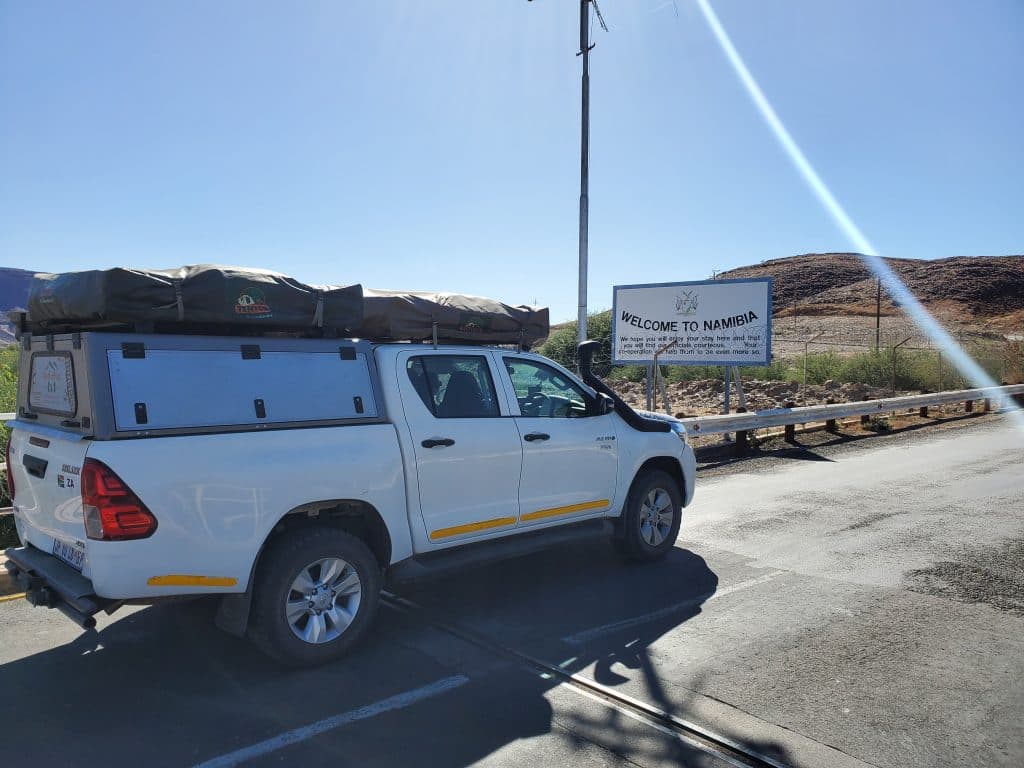
Time: 1.5 hours (no line-up)
Complexity: Easy
EAch border crossing, requires you to exit the current cnuntry and enter the next. These exit and entry points can be in the same builing or down the road from each other. This crossing required stops at five separate offices: health, immigration (visa purchase), the traffic office (to pay a road tax), customs, and a vehicle inspection (agricultural). We were handed a slip of paper with five rectangles and had to collect stamps at each stop, like being at a carnival where the prize is entry into the country.
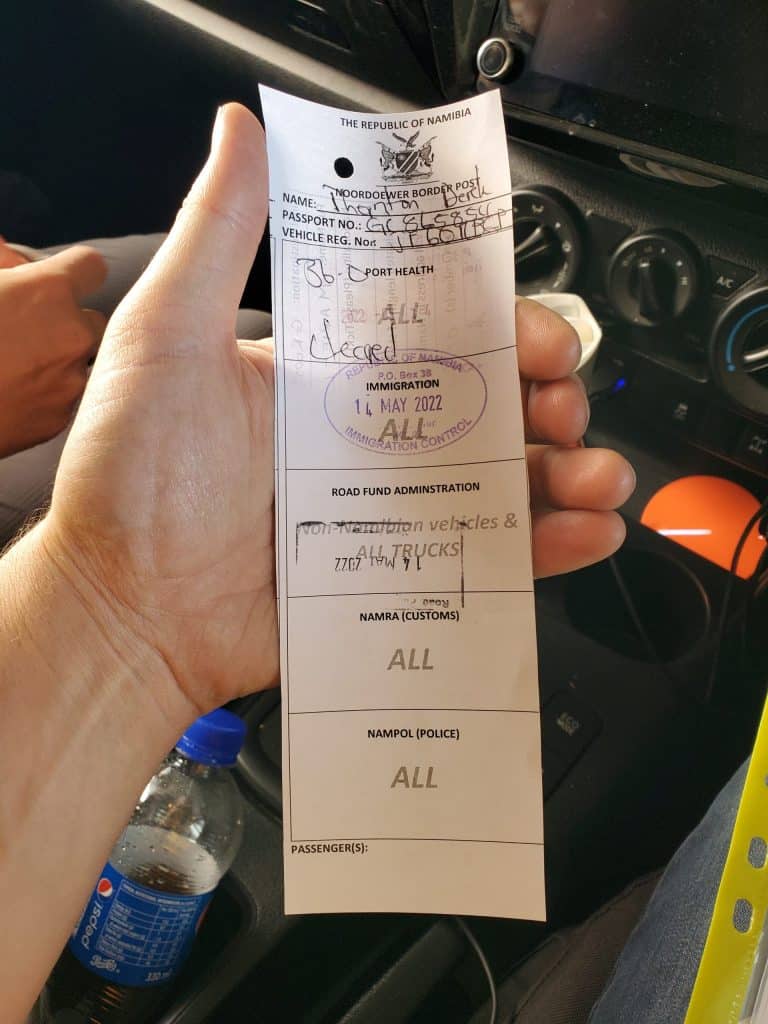
The final step? Place your fully stamped card under a rock on an unguarded table outside. No one checked it, and some people drove off without bothering.
What you’ll need:
- Road tax payment
- Registration and vehicle documents (for rentals)
- Visa payment
Namibia → Zambia (Katima Mulilo Border)
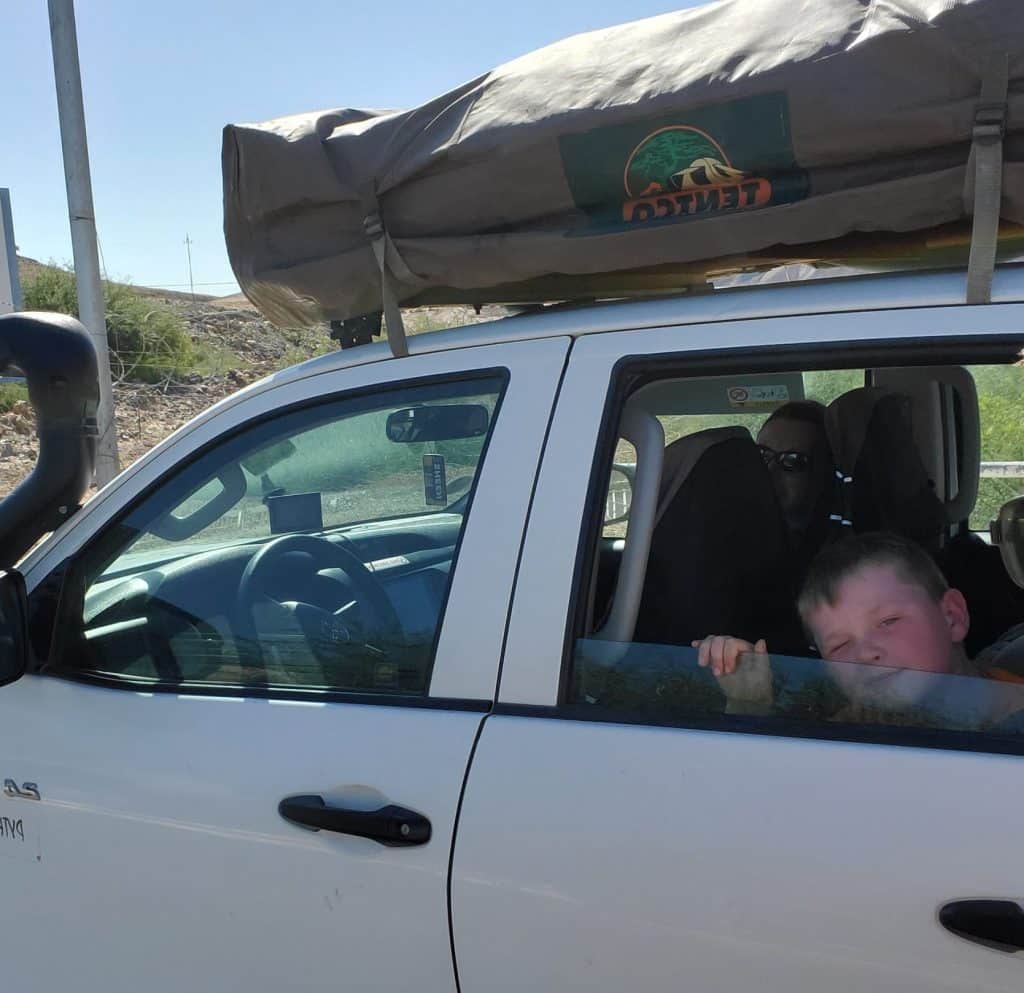
Time: 4 hours (no line-up)
Complexity: High because Zambia isn’t part of the Southern African Customs Union (SACU), which allows easier border movement between countries like Namibia, Botswana, and South Africa. Additional steps in customs are required, particularly when you bring a car across.
- Namibian side: Quick and painless, requiring one stop.
- Zambian side: Several windows repeating similar information to multiple customs agents, piles of paperwork, and inconsistent communication.
We ran into trouble when our rental company failed to provide the correct documents. One crucial form—an International Police Clearance (IPC)—was missing, and we had to pay 750 ZAR (South African Rand) to get a local version issued at the border (which the rental company later reimbursed).
What you’ll need (Zambian Side):
• Visa: Canadian adults, kids free (Paid in USD)
• Road Tax: Cost based on vehicle size (Paid in USD)
• Road Insurance: Mandatory even if you have international road insurance (Paid in Zambian Kwacha)
• Carbon Tax: Paid in Zambian Kwacha
• International Police Clearance form (Provided by rental company or paid in South African Rand)
• Registration and vehicle documents (for rentals)
Currency Tip: Each fee MUST be paid in the specified currency. There’s no ATM, but there is a bank during business hours. Locals will offer currency exchange, but rates are sky-high.
Watch Out: Be cautious of unofficial “helpers” who loiter in the parking lot and buildings. They’ll harass you in and outside of the customs building, give bad advice, offer shortcuts that don’t exist, and pressure you to follow them outside under the guise of helping. Just say no and follow the instructions from the officials. Border guards will not engage with them.
Zambia → Botswana (Kazungula Border)

Time: 1 hour 45 minutes
Complexity: Easy and efficient
Botswana’s process is like Namibia’s—several agents, multiple forms, and road taxes —but noticeably more organized. Our only hiccup was a request for the kids’ birth certificates, which we didn’t have. Passports were not enough; Botswana requires proof of parentage to enter.
Tip: Keep hard copies of birth certificates or download them offline before crossing. Fortunately, we had family back in Canada who emailed us photos in the middle of the night!
Final step: Vehicle inspection. Thankfully, we caught a break. The guards took one look at our fully loaded truck and waved us through without opening a bag.
What you’ll need:
Zambia side:
• Exit tax payment
Botswana side:
• Road tax payment
• Registration and vehicle documents (for rentals)
• Visa Payment
• Birth certificates for minors
Botswana → South Africa (Martin’s Drift Border)
Time: 45 minutes (once we found an open border)
Complexity: Easy—one stop to exit Botswana, one to enter South Africa.
We ran into an unexpected adventure on our way to South Africa. After leaving Limpopo National Park, our first attempt (a 10-minute drive) led to the Platjan border, which had been closed since COVID. We backtracked an hour to the Zanzibar border—only to find the bridge out. Both the Platjan and Zanzibar borders are frequently inaccessible during the rainy season due to flooding of the Limpopo River. The nearest open crossing was 100 km away at Martin’s Drift, reached via rough dirt roads, potholes, and questionable signage. It was a 2-hour detour, but we made it.
What you’ll need:
- Road tax payment
- Registration and vehicle documents (for rentals)
Visa Requirements
Visas are required for many nationalities when entering South Africa, Namibia, Zambia, and Botswana. Requirements vary depending on your passport.
As Canadians, we could purchase visas on arrival at the border, but this isn’t the case for everyone. Some countries require:
• Applying in advance
• Proof of return tickets
• Travel itineraries or accommodation bookings
Tip: Check with official government websites or travel advisories for up-to-date visa requirements before you go.
Border Crossing Tips Recap
• Plan border times: Allow several hours for each crossing, especially if renting vehicles.
• Documents to carry:
– Vehicle registration
– Letter of authorization from the rental company
– International Police Clearance (for Zambia)
– Passports
– Birth certificates for minors (Botswana)
• Currency matters: Bring both USD and local currency. Not all fees accept both.
• Avoid “helpers”: Politely decline assistance unless they are wearing official ID.
• Prepare offline: Download digital copies of key documents and confirm visa requirements.
• Double-check border status: Some crossings remain closed or are hard to access during the rainy season.
Expect the Unexpected
Border crossings in Southern Africa can test your patience, but they also offer insight into the patchwork of systems that make overlanding in this region so unique. With a bit of prep (and a lot of flexibility), these moments become stories you’ll laugh about later, especially when explaining the time you earned your entry with a scavenger hunt style stamp card.
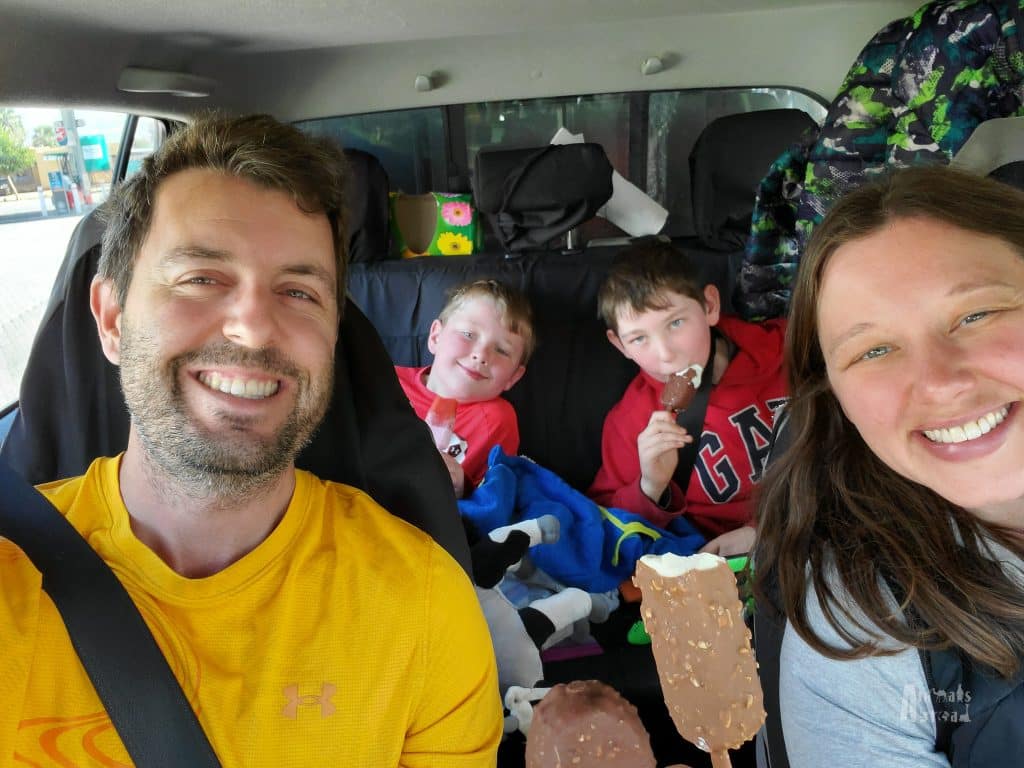
Ready to Start Planning Your Safari Adventure?
Check out these related posts to help plan your trip:
- 51-Day Africa Safari – Part 1: South Africa & Namibia’s Coast
- 51-Day Africa Safari – Part 2: Namibia’s Etosha & Caprivi Strip
- 51-Day Africa Safari – Part 3: Victoria Falls & Botswana
- Our Best and Worst Day on Safari
- Camping Safari in Africa: Know Before You Go
- Camping Across Southern Africa: A Rundown of our Safari Campsites
- Navigating Border Crossings in Southern Africa
- Safari with Kids: Tips from the Road
- Etosha NP with Kids: A Family Safari to Remember
- Exploring the Caprivi Strip with Kids
- Okonjima Family Safari: Where the Wild Things Wait
- The Smoke that Thunders: A Trip to Victoria Falls
- Into the Wild: Chobe NP with Kids
- Sunset Cruise on the Chobe River: A Photo Journey
- Living Giants: A Photo Journey Through Nxai Pan National Park
